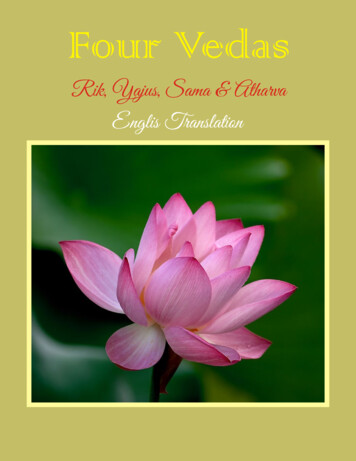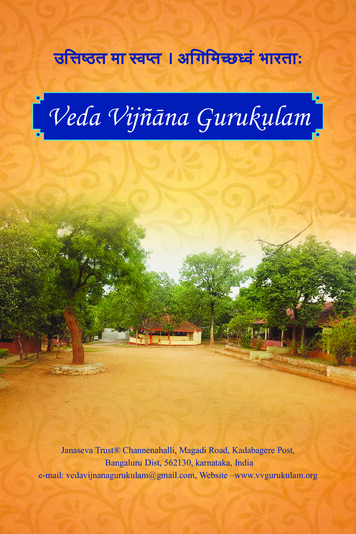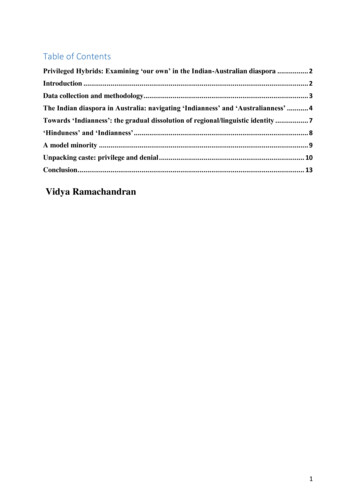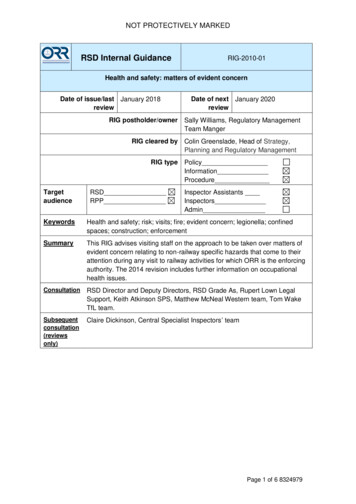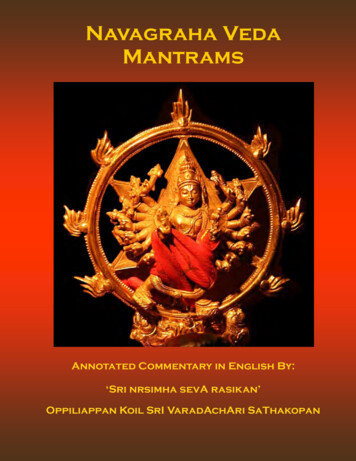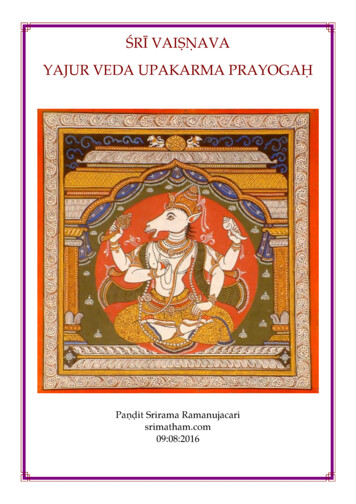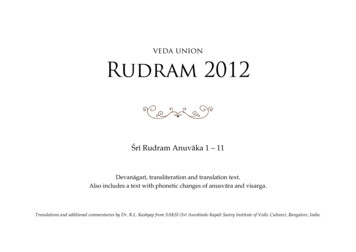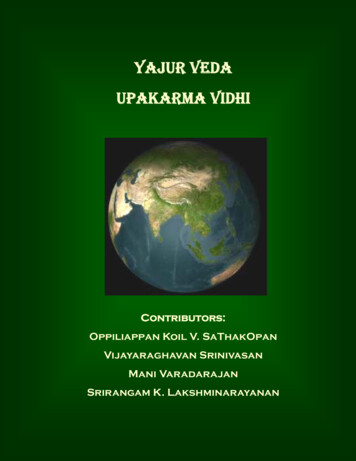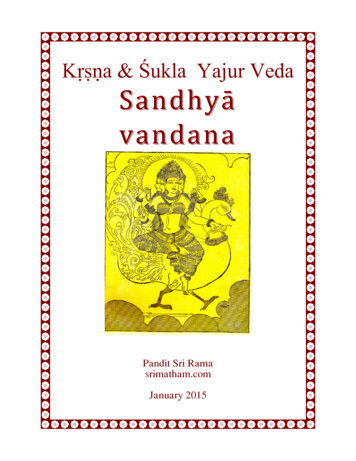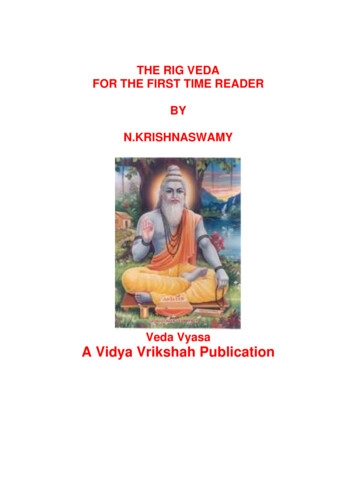
Transcription
THE RIG VEDAFOR THE FIRST TIME READERBYN.KRISHNASWAMYVeda VyasaA Vidya Vrikshah Publication
AUMIS THE SYMBOL OFTHATETERNAL CONSCIOUSNESSFROM WHICH SPRINGSTHYCONSCIOUSNESS OFTHISMANIFESTED EXISTENCETHIS IS THE CENTRAL TEACHING OF THE UPANISHADSEXPRESSED IN THE MAHAVAKYA OR GREAT APHORISMtt! Tv AisTHIS SAYING TAT TVAM ASI TRANSLATES ASTHAT THOU ARTDedicatedto thethree blessings I have received in my life fromthe Universal Mother:My mother Sivakamu, wife Meenakshi and daughter UmaACKNOWLEDGEMENTThis book draws from some of the writings of David Frawley, N.S.Rajaram, S ubhash Kak, GeorgFuerstein, Shrikant Talageri, Narahari Achar, Bal Gangadhar Tilak, Aurobindo Ghose and others. Being int the nature of a review/overview for a small private circulation, for dissemination of their wonderfulvie view points, I have not sought prior approval from them or their publishers. For this I seek theirin indulgence. I have been inspired by their writings and for this I express my gratitude to them.
LIST OF CONTENTSCover PagesPrefaceIntroductionChapter – 1 : CreationChapter - 2 : The Cosmos, Space and TimeChapter – 3 : Speech, Writing and KnowledgeChapter–4 : Ritual, Rationality & SpiritualityChapter – 5 : The People, Kings and SagesChapter - 6 : Civilization, Cities and CommerceChapter – 7 : Archaeology & Support SciencesChapter – 8 : Astronomy and MathematicsChapter – 9 : History, Legend and MythChapter–10 : Past, Present and FutureAppendix - A--------------------------------
ERRATAPage 43 : Please insert the following at the start of the transliterated text :mam§p¡ttasamastaduritakºayadv¡r¡ ¹r param ¹varapr tyartha ¹ubh din ¹§bhan muh rt .Page 50 : Please replace the Sanskrit text and its transliteration as below, but not thetranslation :yåOEn vac: pdv ymayÓtamÓv vÓd t xx p# v¾am .tamaB Ïya ÛydD : p âæOa ta sçO rEBa A B s nvÓtE .yaj na v¡ca: padav yam¡yant¡manvavindann taºiºupadav yam¡yant¡manvavindann taºiºu praviº·¡m .t¡m¡bh ty¡ vyadadhu: purutr¡ t¡ sapta r bh¡ abhi sa navant .Page 76 : Please interchange the titles of the two maps on this pageERRATAPage 43 : Please insert the following at the start of the transliterated text :mam§p¡ttasamastaduritakºayadv¡r¡ ¹r param ¹varapr tyartha ¹ubh din ¹§bhan muh rt .Page 50 : Please replace the Sanskrit text and its transliteration as below, but not thetranslation :yåOEn vac: pdv ymayÓtamÓv vÓd t xx p# v¾am .tamaB Ïya ÛydD : p âæOa ta sçO rEBa A B s nvÓtE .yaj na v¡ca: padav yam¡yant¡manvavindann taºiºu praviº·¡m .t¡m¡bh ty¡ vyadadhu: purutr¡ t¡ sapta r bh¡ abhi sa navant .Page 76 : Please interchange the titles of the two maps on this --------
The Rig VedaFor The First Time ReaderPREFACEKnowledge in society has two dimensions, depth in individuals, andspread across people and places and through time. The knowledge ofmost people is conditioned by their own subjective and objectiveexperiences. But people of all climes and times have always recognizedthat beyond the limits of what they know or sense externally or internally,are vast areas of the unknown, to which they relate through faith in, or fearof, a higher power that appears to control everything, both known andunknown.Every society and every age has always had a small number ofpeople, seers and sages, who have been able to see far beyond theexternal physical world and deep into the internal world of thought,emotion and intuition, for a more integrated and complete understanding ofall human experience. And they have found that subjective experience isinseparable from objective experience and that they are indeed theinseparable faces of the same coin. From this integrated understanding,they drew guidelines for people of every level of understanding, forhandling their lives, which, in time, came to form their scriptures.The Vedas too must have originated in much the same way, andcome to occupy a place of centrality in the lives of the Indian people. Ofcourse, this would be with features similar in many ways, to what hasevolved in other cultures, but in many ways, uniquely different. One refrainfor instance, that is common to many traditions, is the claim to a divineorigin for their scriptures. That the scriptures were the word of God isaffirmed as firmly by the Bible or the Koran as by the Vedas. Without beingdrawn into contentious argument over such statements, it seemsreasonable and adequate for all practical purposes to interpret them tomean that their scriptures found first expression through the minds ofseers and sages, which of course, in their humility, they attributed todivine inspiration, and described as the word of God.The Rishis who thus articulated the Vedas, were obviouslyextraordinary men whose vision traversed the whole gamut of the innerworld of man and the outer world of the cosmos. Seeing everything withina context of Infinity and Eternity, they articulated whatever theyexperienced as best as they could within the vocabulary limits of thelanguage available to them, and possibly, adding sounds and words asthey found necessary or appropriate. And what they saw or sensed and set
into words, acquired the status of divine revelation for the Vedas,represented by the words “Drushti”, meaning “What was Seen”, and“Sruti”, meaning “What was Heard”. Their intuitive faculties did indeed givethem a reach into the highest sources of inspiration, to perceive thehighest truths, and explain them very simply as the divine word heard bythem. The world was described by them in terms of Nama and Roopa, orName and Form. And while Forms were just too numerous, there were fartoo few Names available in the language to represent them. This resulted intheir extensive resort to symbol and synonym, and metaphor and analogyto refer to the Forms, a feature of usage of the language that often wentbeyond the understanding of scholars of later times who were simply notattuned to the word usage and imagery of the ancient times. More oftenthey misinterpreted them to refer to myths or just plain superstition.There are however, several other remarkable features that make theVedas unique among the world’s scriptures. They are now widelyrecognized now as possiblymankind’s oldest. Secondly, they areunquestionably, the most massive and incisive explorations of man in thefields of religion, philosophy and spirituality. And thirdly, they have cometo us in one of the most scientific languages devised by man, namelySanskrit. These claims to uniqueness are recognized by scholars from allover the world, men of enormous scholarship and impeccable credentials,and a sampling of what some of them have said in this regard is set out inAppendix - A. These features will of course, soon become evident to thereader himself as he starts getting glimpses into the Rig Veda presented inthis book.One extraordinary and unique aspect of whatever we have today ofthe Vedas, not to be found in any other culture, is that the texts retain theirentirety, accuracy and authenticity, and form a living presence in the dailylives of the millions of India today, despite the fact that they have beenentirely orally transmitted through the numerous generations of severalmillenia that have passed since the texts were composed. This is due to theestablishment even then, of six supporting disciplines, namely, ), Nirukta(Etymology), Kalpa (Ritual Procedure) and Jyotisha (Astronomy andAstrology). These disciplines, called the Vedangas, or limbs of theVedas, were intended to provide the strict framework; the first four,providing rules for the composition of text, and the last two, the rules ofprocedure of rituals, and determining the auspicious place and time fortheir performance.Specifically for the Vedas, these disciplines weredesigned to ensure that the observance, propagation and preservation ofsacred texts in their pristine purity would endure for all time, despite acompletelyoral mode of transmission. In particular. remarkabletechniques of memorizing and reciting the texts, were designed andprescribed, so that even today, priests and scholars, who have beentrained in this tradition, can pick on any word at any point in anylarge text, and recite it from memory from that point for hours !
These disciplines enabled adoption of an extraordinary inter-lockingstrategy to establish the above objective, a strategy operating at severallevels, and across vast spans of time and distance. At the most basic levelof this strategy, a strict grammatical structure of the language and themeter of the compositions provided a rigid framework for the texts. Everywork also carried inbuilt references to the authorship and size of eachlevel of the component text. At the next level, highly developed teachingmethods resting on highly scientific techniques for memorizing the textswere prescribed and followed, as indicated earlier, where recitation couldnever go wrong. The texts were embedded into strict rituals, resting onhope of rewards and fear of punishments, that commanded theunquestioning faith of the common people as a whole, and become part ofthe psyche of the people. And at the final level, successive generations ofteachers and disciples carried the Vedas to different parts of India,and in the courseof time, the processes of their observance,propagation and preservation got institutionalized into Sakhas orSchools, each with a large membership, and each of whom preservedand opanishad has it that at one time, there were 1180 Sakhas inexistence, but only a handful survive today. Not counting severalfragments that have been retrieved over the years, the following is asummary of the surviving complete Sakha-wise component texts,preserved by the large membership of each Sakha :SamhitaBrahmanaAranyakaUpanishadRIG YAJUR16232336SAMA293ATHARVA112It will be of special interest to the first time reader, to look, at theoutset, at a few examples of how the lofty thought, spirit, form and wordsof the Vedas as they were composed over 6000 years ago, continue intactas a living tradition in our daily lives in India today. One verse, for instance,that is central to the prayers we offer today is the Gayathri Mantra thatoccurs in the Rig Veda (V-62-10), and is attributed to the Rishi ViswamitraThe following is the Sanskrit text with a Roman transliteration and anEnglish translation :
‘ B : ‘ B v: ‘ s v:§m bh : §m bhuva §m suva tt s vt : vrEÎym tat savituh: var ²yamBga I dEvÞy D m hbharg§ d vasya dh mahi DyaE yaE n: p#caEdyat dhiy§ y§ na prac§day¡tThe Mantra is invoked in the first line of above text with the holysound OM applied to Bhu, Bhuvah and Suvah, respectively representingthe gross Physical, the subtle Spiritual and the potential Causal planes ofall existence. The Mantra itself then follows in the next three lines whichtranslate as below :We meditate upon the effulgence of that Divine Reality. May that DivineBeing, the Sun, illuminate our intellect to realize That Reality.The use of the plural “n:” meaning “our”, may be noted : the prayer is notfor oneself, but on behalf of all.To make the perspective complete, whenever today, anyone announces hisidentity to his elders, it is always typically in terms of his inheritance ofthis ancient tradition in the following words in Sanskrit which transliterateand translate as below :A BvadyE vWáa mæO, AaGmxIN, k Sk, æOy æOy Aax Iy p#vra Óvt,(k Sk) gaEæO: (AapÞt b) s æO:, (yj :) SaKaÒyay , ½ ( ( ) ) SmaInama{h A Þm BaE:.abhiv¡day vai¹v¡mitra, ¡ghamarºa²a, kau¹ika, traya traya ¡rº ya pravar¡nvita, kau¹ika g§tra: ¡pasta ba s tra:, yaju:¹¡kh¡dhy¡y , ¹r ( name) ¹arm¡ n¡m¡aha asmi bh§:.Bowing to you, Sir, I announce myself as belonging to the spiritual lineageof the three Sages Viswamitra, Akarshmana and Kausika, to the familylineage of the Kausika Gothra and to the religious disciplines of theApasthamba Sutra of the Yajur Veda, and I bear the name (so-and-so).
The reader will now see the truth of the statement made earlier thatthe ancient tradition has a living presence in our daily lives today. Whothen were the Rishis like those whose names appear as above, whofounded this tradition, from whom we are descended, whose injunctionswe follow, and who composed the hymns that we recite today ? And whowas Vyasa who retrieved all the scattered remains of the thousands ofthose hymns composed by hundreds of such Rishis in remote antiquity,and compiled them into the single massive canon of the four Vedas, theRig, Yajur, Sama and Atharva, on which the ancient Indian tradition isfounded and has reached us today across the millenia ? And when did heaccomplish this ?All that we know today of these ancient Rishis is that they werequite a large number and lived in the 1000 years preceding Vyasa whohimself lived towards the close of the Dvapara Yuga which ended in 3102BC, the year that marked the start of the Kali Yuga. One important point toremember here is that the number of these ancient Rishis was large andtheir output was prolific. Thus typically, the Rig Veda alone as compiled byVyasa, had 10028 hymns and are attributed to as many as 414 Rishis,whose names are recorded in the Anukramanis, the Indices embedded inthe Veda text itself. The original composition of Rig Veda is considered tohave occurred over a time span of 1000 years or more, preceding the timeof their compilation by Vyasa at the time of the Mahabharata War, whichitself is placed at around 3102 BC. This would place the composition of theRig Veda, the oldest of the Vedas at around 4000 BC or perhaps muchearlier, because of references in the Rig Veda itself, to earlier ancientRishis. The above dating of the Mahabharata War, described in the greathistoric epic of the same name, and composed by Vyasa. rests on its owninternal evidence, which is substantial and substantive.Vyasa, is the great poet and vis
RIG YAJUR SAMA ATHARVA Samhita 1 6 2 1 Brahmana 2 3 9 1 Aranyaka 2 3 - - . occurs in the Rig Veda (V-62-10), and is attributed to the Rishi Viswamitra The following is the Sanskrit text with a Roman transliteration and an English translation : ‘ B : ‘ B v: ‘ s v:‘ B : ‘ B v: ‘ s v: tt s vt : vrEÎym tt s vt : vrEÎym Bga I dEvÞy D m hBga I dEvÞy D m h .
